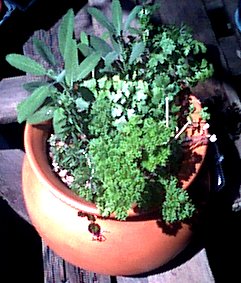
I recommend growing all your herbs in CONTAINERS. This will enable you to keep the plants evenly moist and fed in hot months without wasting water, and during very hot periods you can move the containers into a shadier or cooler area if you need to.
The only way that most traditional herbs can be grown in the ground in the desert is to make sure that the plants will be in full, open SHADE April thru September (under a large tree, for example). The ground around the plants will need to be kept moist at all times during these hot months- a drip system that runs daily will work for this. Herbs that "take over" in other climates (mints, fennel, etc), won't do it here- they will only grow in damp soil in the desert.
A note about WATERING. When you water your plants be sure that you water THOROUGHLY. For plants in the ground water well enough so that the soil will be wet to the depth of all the plants' roots. For plants in containers make sure that the water runs out the holes in the bottom of the container.
Between October and March, we generally get nights BELOW FREEZING. Annual herbs (basils, borage, etc) will die with the first hard frost. Tender perennial herbs like scented geraniums and marjoram will need protection such as being under a covered patio or covered with cloth or paper. Hardy perennial herbs like mints, oregano, German chamomile, thymes and so forth will actually love this cold season much more than they do the summer! All perennial herbs should be kept damp but not soaked at this time. Watering twice a week should be sufficient. Try to make sure that these herbs get a couple of hours (at least) of full sun during these months of least sun intensity.
April thru September are our hot, generally dry months. Keep the soil your herbs are growing in EVENLY MOIST (catnip, thyme, and oregano can get away with drying out slightly). Feed your herbs during this period with any good houseplant food once a month. At this time most herbs will appreciate being kept in the FULL SHADE all day, or perhaps just an hour of EARLY MORNING sun. In June and July when the air is very dry mist the foliage often or move the plants indoors to an air- cooled area, if needed.
When repotting your herbs, use a houseplant mix- please please please DON'T use dirt from the ground- you don't know what bugs, bacteria, fungi, etc you're picking up in the soil- and in the confines of a container that can be disastrous!
Most BUGS that attack herbs (in the desert that will be mostly aphids and whiteflies!) can be gotten rid of with a spray of Insecticidal Soap- it is just as effective and much safer for you and the environment than pesticides.
I know all this seems pretty complicated and labor- intensive. Yet I feel that many herbs are of such benefit, if only to make that pot of stew taste better, that the extra care that they require is justified.
|
Arid Lands and the Plants That Make Their Homes There: Back to the introductory page on desert plants, plant care, etc. Answers to Some Questions About the Desert: Frequently asked questions, tidbits, and more. Cactus Care: Information on light requirements, transplanting, watering, feeding, and so on. Desert Plants: Shrubs; Ocotillos; etc.: Information on caring for drought- tolerant natives and non- natives; perennial wildflowers, too! The Sonoran Desert and Her Plants: Back to the Home Page Turtle Woman Site Archive: Back to the OLD Home Page |